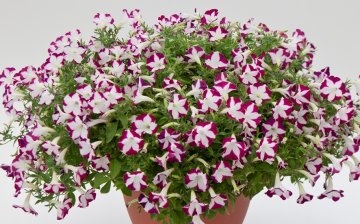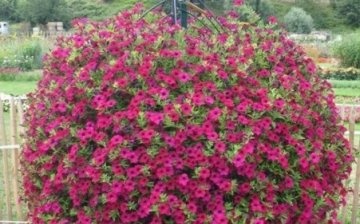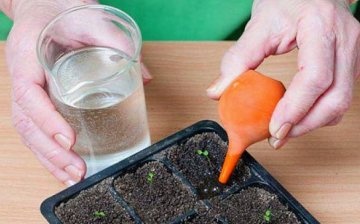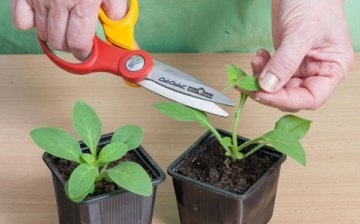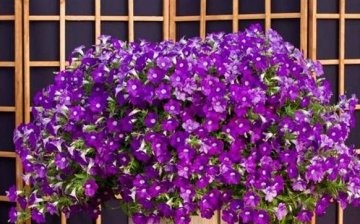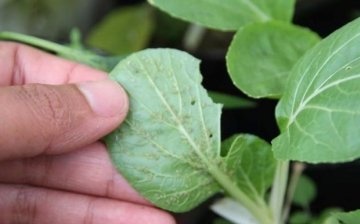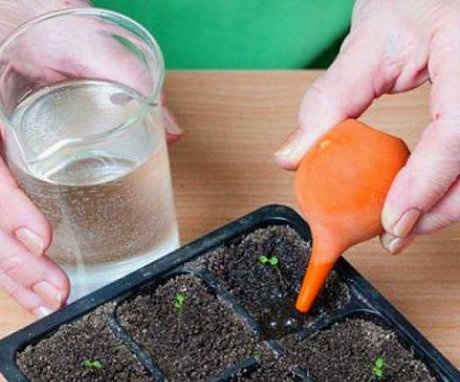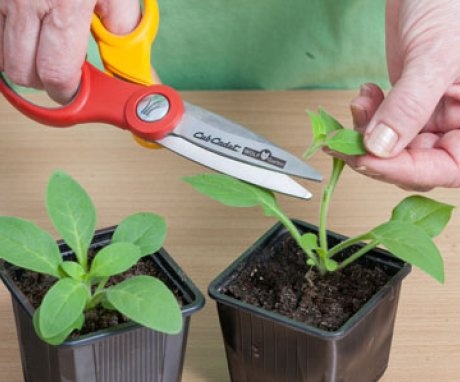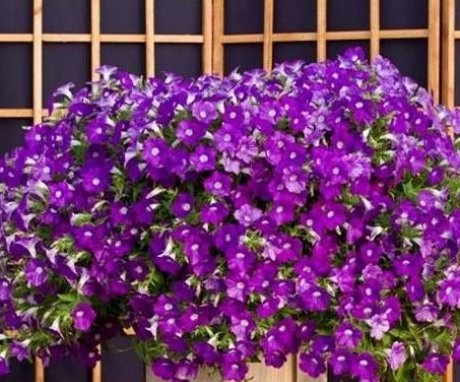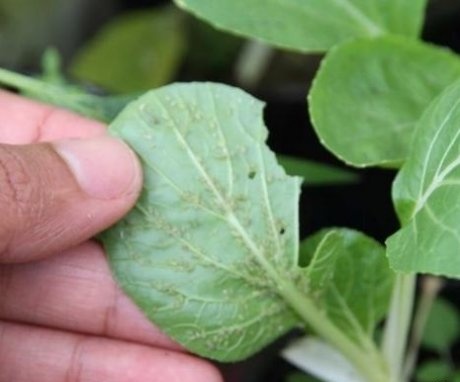Petunia Blanket: all about growing a plant
Like a bright fireworks display, multicolored inflorescences of a close relative of potatoes and eggplant, namely the favorite of many gardeners of a perennial plant, dance on long stems. The flower is unpretentious and grows in almost any non-lazy florist, and at the same time it presents with bright flowering, successfully decorating city balconies, small architectural forms in the garden and other objects of garden creativity. At the same time, petunia Vlanket is unlimited by ampelous cultivation, it looks quite good on flower beds, fills the lower tiers of alpine slides well and can show itself perfectly, creating a contour around buildings.
There are many species variations of this culture. Breeders experiment not only with the color of the buds, but also release on the market specimens that can be formed by pruning, grown in the form of a low shrub. For example, the varietal series under the general name Petunia Blanket was liked by many gardeners.
Content:
- Description of the variety
- How to turn seeds into flowers
- How to care for adult seedlings
- Petunia Blanket care
- Diseases and pests
Description of the variety
Translated from French Vlunket, this is a blanket. And the name very clearly reflects the whole essence of this species. With proper care and with any type of cultivation, such a variety of petunias grows and covers the nearest surfaces as if with a blanket. Rising from the roots on a rigid woody base by 13-20 cm, the stalks of the stems reach a meter in length, which looks interesting both in the ground cover version and in ampel cultivation.
The variety is rapidly gaining strength and final shape, since it initially has good growth rates and the landowner does not have to wait for the first tender shoots to sprout.
Of course, when choosing a place for a given plant, it is necessary to take into account its spreading, since the diameter of the growth of the lashes reaches 2.5 m.
The variety is quite easy to grow, as the plant has strong immunity. But when buying seeds or seedlings, you should pay attention to the source material manufacturer, and buy only from reliable sellers. Although in the second year it is not difficult to grow petunia from their seeds. True, not all hybrid varieties convey color.
How to turn seeds into flowers
A reliable and easy way to infuse your plot with gorgeous blooming petunias is to grow seedlings from seeds. When buying ready-made seedlings, there is always a risk that unscrupulous sellers have used up the entire starting volume of the plant power of the flower at the very beginning, since they used too many growth stimulants to give it a presentation.
In the case of petunia, even a novice gardener can grow seedlings. Observing a few simple rules at the exit, you can get strong friendly shoots, which will soon turn into chic multi-colored thickets:
- Priming. It can be purchased or prepared in the fall by collecting soil from your site. Different soil mixtures are suitable for petunias, the only exceptions are acidic or alkaline compositions. The soil mixture should be loose, nutritious and retain moisture well. But you definitely need to take care of drainage. Since the culture does not like to keep feet in water for a long time, it starts to hurt.
- Lighting... The ideal option would be if the boxes with seedlings can be installed next to sources of additional lighting or under phytolamps... But in the absence of such an opportunity, a window sill on the south or southeast side will also do.
- Temperature. The optimum temperature for good germination is 20-25 C. But you should avoid growing seedlings over heating devices. In this case, the soil will dry out quickly and the seeds will not receive enough moisture. The construction of mini-greenhouses gives a good result in matters of temperature control. The role of such greenhouses is successfully performed by simple plastic containers in which cottage cheese or sour cream is sold on the market. The main thing is not to forget to make holes in the cover for air access.
How to care for adult seedlings
After petunia pleased with the appearance of the first greenery, it is necessary to feed the babies so that they develop well. Foliar dressing is now useful, since spraying with water-soluble fertilizers will give greater results. Root system it is still weak, and the leaf area is already large enough to assimilate well the substances necessary for growth.
If the seedlings of Petunia Blanket give poor results, then you can resort to the help of growth stimulants, but this must be done carefully.
Waterlogging of the soil should be avoided, otherwise successfully sprouted seedlings may die. If, nevertheless, it was not possible to keep track, watering should be sharply reduced. Further, the seedlings must be transplanted into another soil, because waiting until the soil dries out will have a detrimental effect on the state of the plant. For transplanting seedlings, it is worth using boxes with a mesh of 6 x 8 cm. Peat or plastic seedling boxes must be filled with soil and after planting the plants, they should be covered with paper, burlap or lutrasil for several days.
Ten days before the petunias move to their permanent place of residence, it is necessary to carry out the hardening procedure. During this, watering should be reduced and try to distribute the fertilization in such a way that during the hardening period the presence of nitrogenous fertilizing is minimal. Hardening begins with a few hours of the day outdoors, and by gradual stay in the fresh air is brought to around the clock.
And some more useful tips for successful forcing seedlings:
- hydrogel can be added to the soil, then the watering of the seedlings will be reduced, this reduces the leaching of nutrients from the soil
- no need to bury the seeds in the ground. It is worth carefully scattering the grains over a damp surface of the earth and moisten them from a spray bottle on top, and then pour a thin layer of dry soil on top of this.
- the first week, you can spray the soil several times a day with a weak solution of potassium permanganate or Fitosporin-M
- adult seedlings will be properly watered through the pallet. This technique has a good effect on the development of the root system, the main thing is to drain off excess moisture an hour after watering.
Petunia Blanket care
Before talking about how to care for petunia, you need to choose the right place. Regardless of the growing method, the place should be well lit. Although the plant does not complicate the life of the gardener with its whims, do not forget that it gives a lot of energy so that a person can observe a long flowering without much hassle. Therefore, having initially created good conditions, you can no longer worry that the darling of the garden feels uncomfortable.
When grown outdoors and in pots, the first step is to make good drainage.
Especially when grown in soil. Stagnant water will destroy even the strongest seedlings, provided that watering must be abundant. On hot days, a double watering plants.
Feed an adult Blanket petunia regularly. Complex formulations that are applied in liquid form are well suited.Until the petunia reaches an adult state, it should be fed twice a week, but as soon as the plant has formed and a large and powerful bush is already blooming in the garden, then feeding can be done almost daily. Although, for open ground, of course, an exception must be made. It all depends on the composition of the soil.
Diseases and pests
Although petunia is a rather strong plant, it is not always possible to avoid meeting pests:
- Whiteflies. If yellow leaves appear with proper care, then it is worth looking at the back of the foliage. There you can see a cluster of white midges. It is good to catch them and suppress the appearance of offspring with the help of glue traps. In case of strong reproduction, it is better to treat the plant with Mospilan.
- Spider mite. White discharge and cobwebs on petunia clearly show the presence of this pest. Dandelion infusion or the drug "Neoron" will help.
- Aphid... This natural disaster will certainly take a fancy to petunia if it approaches the garden. They are well destroyed by natural enemies, such as a ladybug or chemistry in the form of the drug "Aktara".
- Thrips. Invisible pests leave quite noticeable traces of their stay in the form of white stripes and veins on the leaves. The plant urgently needs to be treated with an insecticide.
- Slugs. These comrades simply leave holes in the leaves and begin to actively destroy the plant. You can have guinea fowl in the garden, or sprinkle the ground around the petunia with superphosphates. And collect everyone who has already overcome the obstacle course by hand.
But not only pests affect the beautiful petunia. Sometimes viral diseases also do not pass by the flower:
- Phytosphorosis. The base of the stem darkens and decays. Since the cause is abundant dew and a sharp cold snap in the dark, the plant should not only be treated when the disease occurs, but also preventive treatment. "Ridomil" and "Profit" are good help, in both cases.
- Black leg fungus. It affects young plants. If you start the disease, then you can lose not only petunias. Basically, this disease likes to settle in gardens with a high planting density. Preparations containing sulfur will help get rid of this ailment.
- Gray rot. Lack of light and excess nitrogen are factors for the development of this disease. It is necessary to cut off damaged parts and clean the soil of rotten leaves. Feed the plants with preparations in which the content of potassium and phosphorus is high.
Choosing the Blanket variety among the petunias, the gardener, mixing different species variations in one container or in the same area, gets an excellent variety of not only shapes, but also colors. Moreover, the good response of the plant to the formation of lashes and good covering ability makes it appropriate in any part of the garden.
More information can be found in the video:



